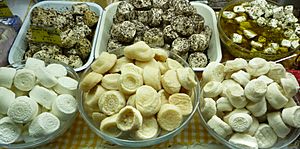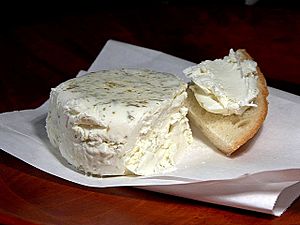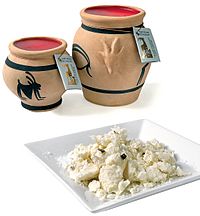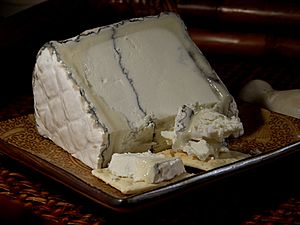Goat cheese facts for kids
Goat cheese, also called chèvre (say "SHEV-ruh"), is a type of cheese made from goat's milk. The word "chèvre" comes from French and simply means "goat cheese."
Goats were some of the very first animals people raised for food. Goat cheese is made all over the world. There are many different kinds, from soft and fresh to hard and aged.
Contents
All About Goat Cheese
A Look Back in Time
Goats are amazing animals! They can produce lots of healthy milk even in tough places. This makes them very important in dry or mountain areas. Cows and sheep might not survive there, but goats can.
People started raising goats for their milk about 10,000 years ago. This was around 8,000 B.C. Making goat cheese began even earlier, about 7,000 years ago. The first time we know for sure that humans made cheese was 7,500 years ago in Poland.
What Makes it Healthy?
Goat milk has special fats called medium-chain fatty acids. These fats give goat cheese its unique tangy taste. They also make goat milk and cheese easier for your body to digest.
Goat milk and cheese are packed with good stuff! They have things that help fight swelling in your body. They also contain helpful bacteria (probiotics), things that protect your cells (antioxidants), proteins, and fats. All these help keep your body working well. Goat cheese is also full of calcium, vitamins A and K, phosphorus, thiamin, and niacin.
How Goat Cheese is Made
Making goat cheese is a lot like making other cheeses. First, the milk is cleaned to remove any unwanted bits. Then, a special ingredient is added to make the milk curdle. This can be rennet or certain bacteria. These ingredients help form the cheese curds. They also affect how firm the cheese will be.
Next, the curds are separated from the whey. Whey is the liquid part of the milk that doesn't curdle. The curds are then shaped, dried, and sometimes flavored. They might also be aged for a while. Small changes in how it's made can create many different textures. This is how you get soft, semi-hard, or hard goat cheeses.
Different Kinds of Goat Cheese
From Asia
China
- Rubing is a fresh goat cheese from Yunnan Province in China. It looks a lot like paneer, which is a cow's cheese from India.
- Shosha is a strong-smelling cheese. It is a main food in Tibetan cuisine. This cheese is often made from goat or yak milk.
Japan
- Yagi Cheese is simply goat cheese made in Japan. "Yagi" is the Japanese word for goat.
Middle East
- Darfyieh is a tasty cheese from baladi goats. It is seen as a special treat in Dargyieh.
- Djamid or Jameed is a hard, unripened cheese with a salty crust. It is popular in Jordan and Syria.
- Labneh is a thick, strained yogurt that is eaten in many parts of the world. It's popular in Egypt, Lebanon, Syria, Palestine, and Jordan. You can eat it with olive oil, mint, in salads, or even as a dessert.
From Europe
France
France makes many goat milk cheeses, especially in the Loire Valley and Poitou.
- Chevre is a soft, creamy cheese that melts in your mouth. It can have a fruity taste. It usually has a light-colored rind and is not aged for very long. Sometimes, it's served warm as chèvre chaud.
- Famous French goat cheeses include Bucheron, Crottin de Chavignol, Pouligny Saint-Pierre, and Sainte-Maure de Touraine.
Greece
- Feta is mostly made from sheep's milk, but it can have up to 30% goat milk.
- Mizithra is a cheese made from the liquid left over after making other goat cheeses. It can be eaten fresh or dried.
- Anthotyros is another cheese made from leftover whey. It can use milk from goats, sheep, or both. It is served fresh or dried.
Italy
- Caprino is a name for at least 33 different goat milk cheeses made in Italy. It's like the French word "chèvre."
- Ricotta is also made from whey, the liquid left from cheesemaking. "Ricotta" means "re-cooked." The whey is heated again until cheese curds float to the top. These curds are then scooped out and shaped.
Malta

- Ġbejna is a small cheese made from goat's or sheep's milk. There are many types, like fresh, sun-dried, salt-cured, or seasoned with pepper.
Netherlands
- The Westerkwartier region has many organic goat cheese farms. Some well-known goat cheeses from this area are Machedoux and Quiorio. These are soft, brie-like cheeses. In other parts of the Netherlands, goat cheese is often made in the Gouda style.
Norway
- Geitost means "goat cheese." It is a brown cheese made from goat milk and whey. Other brown cheeses might also use cow milk whey.
- Snøfrisk is a fresh goat milk cheese. It often has extra flavors added to it.
Portugal
- Castelo Branco is a Portuguese goat milk cheese.
- Trás-os-Montes is a goat milk cheese from the Norte Region of Portugal.
Spain
- Mató is a fresh cheese from Catalonia. It can be made from cow's or goat's milk.
- Garrotxa is a firm goat cheese from northern Catalonia.
- Nevat is a soft goat cheese, also from Catalonia.
- Majorero cheese is a goat milk cheese from the Canary Island of Fuerteventura.
Turkey
- Tulum cheese is a goat cheese made in Turkey.
- Sepet cheese and Kaşar cheese are also made from goat milk. They are sold as Goat Sepet cheese and Goat Kaşar cheese.
- Beyaz peynir means "white cheese." It is a brined cheese made from sheep, cow, or goat milk.
- Ezine Cheese is a type of Beyaz Peynir. It must have at least 40% goat milk.
United Kingdom
- Pantysgawn is a Welsh goat milk cheese.
- Capricorn is a goat milk cheese from Somerset, England.
From the Americas
United States
- Kunik is made in New York. It mixes goat and Jersey cow milk. It is a soft, mold-ripened cheese, similar to Brie.
- Humboldt Fog is a mold-ripened goat cheese from California. It has a line of edible white ash in the middle.
Venezuela
- In Venezuela, especially in the states of Falcón, Lara, and Miranda, many types of goat cheese are made. Smaller producers make a variety of traditional cheeses.
See also
 In Spanish: Queso de cabra para niños
In Spanish: Queso de cabra para niños





